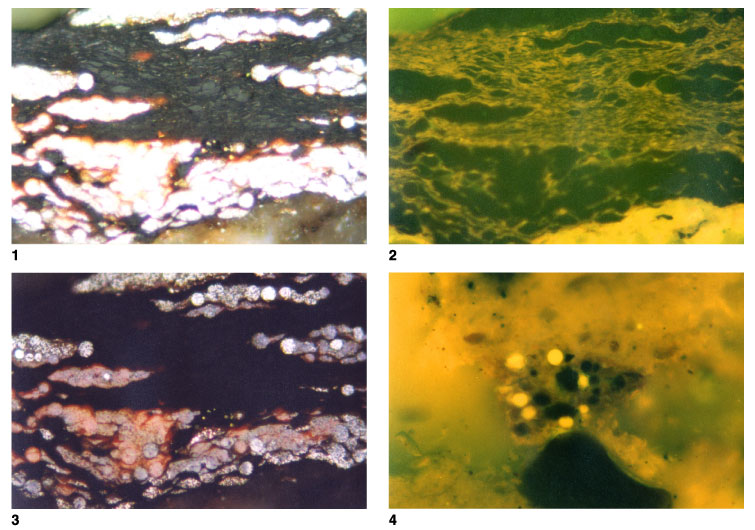
Plate P7.
Vitrinite, pyrite, and oil inclusions. 1.
T5863; Hole 1118A; 744.27 mbsf. Telovitrinite with fluorescing cell walls and
abundant layers of pyrite. This plate has been exposed to illustrate the
vitrinite and figure 3 to show the pyrite (reflected light; field width = 0.22
mm; mean vitrinite reflectance = 0.36%). 2.
T5863; Hole 1118A; 744.27 mbsf. Telovitrinite with fluorescing cell walls and
abundant layers of pyrite. The pyrite appears dark in fluorescence mode, and the
small fluorescing areas within the pyrite lenses may represent remnant plant
structures that have been largely replaced by pyrite (reflected light; field
width = 0.22 mm; mean vitrinite reflectance = 0.36%). 3.
T5863; Hole 1118A; 744.27 mbsf. Telovitrinite with fluorescing cell walls and
abundant layers of pyrite. This plate has been exposed to illustrate the pyrite.
The brighter areas are unaltered pyrite, but most of the original framboidal
pyrite has been altered to iron oxides. It is thought that this alteration has
occurred during drying of the sample and indicates that the pyrite is highly
reactive (reflected light; field width = 0.22 mm; mean vitrinite reflectance =
0.36%). 4. T5842; Hole
1115C; 514.72 mbsf. Oil drops within siltstone. These oil drops are relatively
rare in the sample suite. Some occurrences are probably contaminants, but these
appear to be indigenous to the sample. Light paraffinic oils have this
appearance in fluorescence mode (reflected light; field width = 0.22 mm; mean
vitrinite reflectance = 0.29%). Click on image or number to see enlargement.



![]()